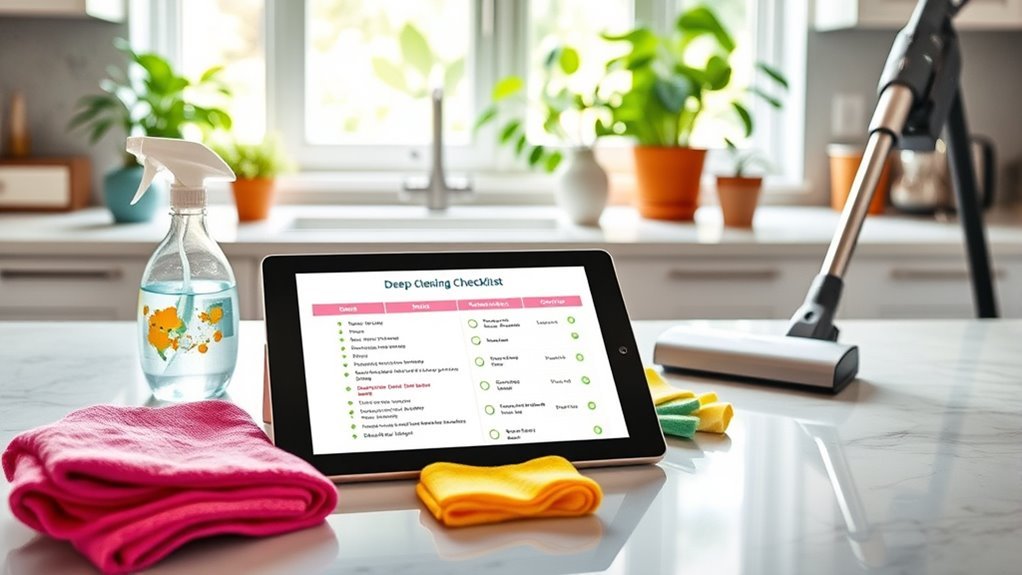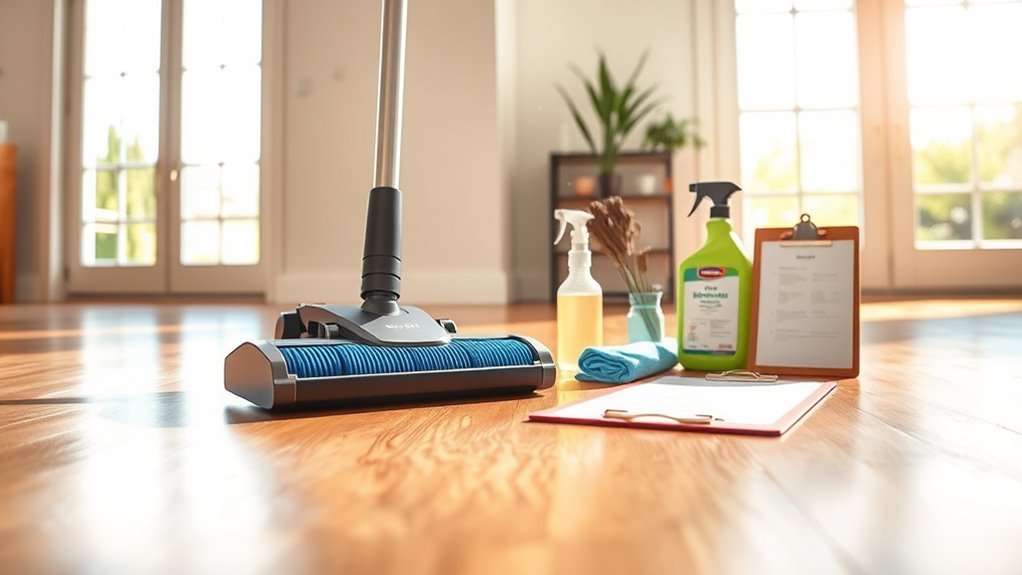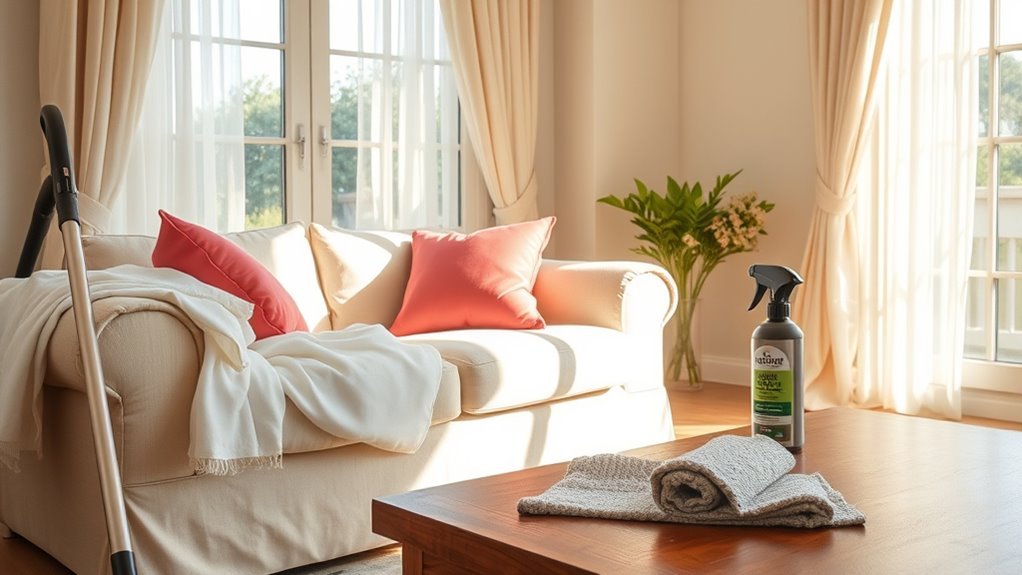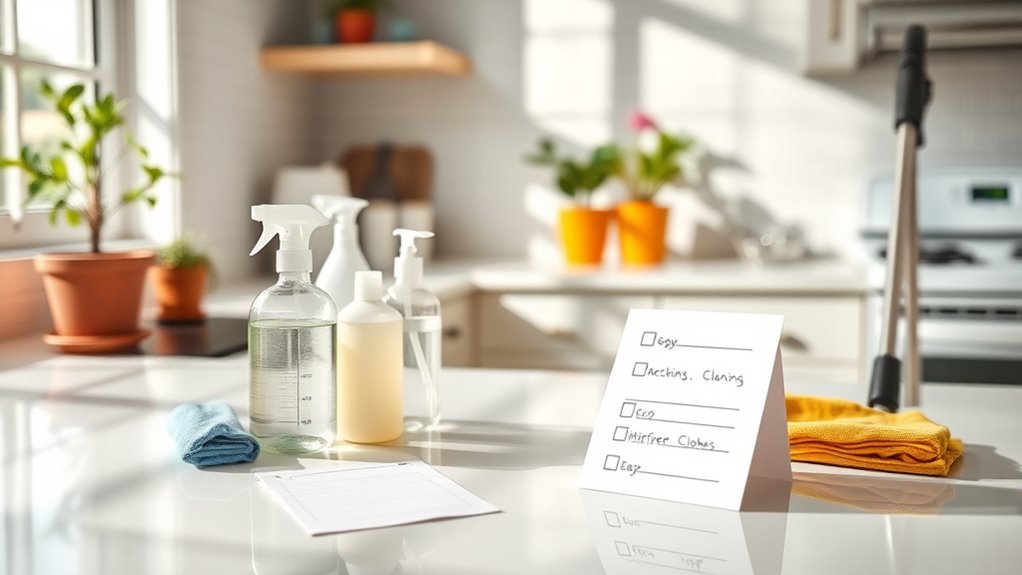Deep Cleaning Checklist for Allergens
To deep clean for allergens, start by targeting dust mites, pet dander, mold, and pollen. Use a HEPA-filter vacuum and microfiber cloths to trap particles effectively. Wash bedding weekly in hot water and clean upholstered furniture and curtains regularly. Manage pet dander by grooming pets and controlling moisture to prevent mold growth. Maintain indoor humidity between 30-50% and use HVAC systems with high-efficiency filters. Following these steps will help you considerably reduce allergens and improve air quality. More detailed strategies await inside.
Identifying Common Household Allergens

Although allergens can be found throughout your home, it’s crucial to identify the most common sources to target your deep cleaning effectively. Common sources include dust mites, pet dander, mold spores, and pollen that infiltrates indoor spaces. Dust mites thrive in bedding and upholstered furniture, releasing proteins that trigger allergy symptoms such as sneezing and congestion. Pet dander, composed of microscopic skin flakes, accumulates on surfaces and fabrics, exacerbating respiratory issues. Mold grows in damp areas like bathrooms and basements, producing spores that provoke asthma and irritation. Pollen enters through windows and settles on surfaces, intensifying reactions during peak seasons. By pinpointing these allergens, you can focus your cleaning efforts strategically, minimizing exposure and improving your indoor air quality for greater freedom from allergy symptoms. Recognizing allergens helps target cleaning efforts effectively and leads to a fresher, cleaner living environment by reducing common household allergens.
Preparing Your Cleaning Supplies
Before starting your deep clean, gather essential tools like HEPA-filter vacuum cleaners, microfiber cloths, and scrub brushes. Choose products formulated to target specific allergens such as dust mites, pet dander, or mold spores. Opt for safe chemical alternatives to minimize respiratory irritation and environmental impact during cleaning. Regular grooming sessions are also crucial for reducing allergens at the source by controlling pet hair and dander.
Essential Cleaning Tools
A well-prepared set of cleaning tools is essential for effectively reducing allergens in your environment. To maintain freedom from irritants, you need essential supplies designed for thorough allergen removal. Focus on tools that capture dust and prevent redistribution rather than just surface cleaning.
- HEPA-filter vacuum cleaner – traps microscopic particles.
- Microfiber cloths – attract and hold dust without spreading it.
- Extendable duster – reaches high and tight spaces.
- Rubber gloves – protect skin from irritants while cleaning.
These cleaning tools are the foundation of your allergen control strategy. Using the right equipment maximizes efficiency and minimizes exposure, allowing you to maintain a cleaner, healthier living space with less effort. Equip yourself with these essential supplies to reclaim your environment confidently.
Allergen-Specific Products
When targeting specific allergens, you’ll need products formulated to neutralize or remove those irritants effectively. Opt for allergen free products designed to break down dust mites, pet dander, mold spores, and pollen without leaving harmful residues. Eco friendly cleaners are ideal, as they minimize chemical exposure while maintaining efficacy. Look for labels that specify hypoallergenic properties and dermatologically tested formulas to guarantee safety and comfort. Concentrated solutions often provide better penetration for deep cleaning. Additionally, avoid products containing fragrances or dyes that can trigger sensitivities. Preparing your cleaning supplies with these targeted options empowers you to maintain a healthier environment, granting you freedom from persistent allergens. Prioritize precision in selection to optimize your deep cleaning results and safeguard your indoor air quality.
Safe Chemical Alternatives
Choosing allergen-specific products sets the foundation, but it’s equally important to contemplate safe chemical alternatives for your cleaning supplies. Opting for natural cleaning agents and eco-friendly solutions reduces exposure to harsh toxins that can trigger allergic reactions. You should prioritize:
- Vinegar and baking soda for versatile, non-toxic scrubbing.
- Essential oils like tea tree or eucalyptus for antimicrobial effects.
- Plant-based surfactants that effectively remove dirt without synthetic chemicals.
- Hypoallergenic, fragrance-free products certified by reputable environmental organizations.
These alternatives not only minimize airborne irritants but also support indoor air quality improvement. By preparing your cleaning supplies with these safe chemicals, you maintain an allergen-reduced environment while preserving your freedom to choose effective, non-toxic methods. This approach guarantees your cleaning routine is both health-conscious and environmentally responsible.
Dusting and Wiping Surfaces Effectively
Although dusting and wiping might seem straightforward, doing it effectively requires specific techniques to minimize allergen presence. You’ll want to adapt your dusting techniques based on surface materials; for example, microfiber cloths excel on smooth surfaces, capturing dust without dispersing it into the air. For delicate wood or electronics, use gentle, electrostatic dusters to prevent damage while trapping allergens. Always dust from top to bottom, starting with higher surfaces to avoid recontamination. When wiping, apply a damp cloth with an appropriate, allergen-free cleaner to remove residual particles rather than just redistributing them. Avoid dry dusting methods that can aerosolize allergens. By tailoring your approach to each surface’s characteristics, you’ll effectively reduce allergens, creating a cleaner environment and maintaining your freedom from allergy symptoms. Using natural cleaning products can further minimize exposure to chemical pollutants while cleaning.
Vacuuming With HEPA Filters

You’ll want to use a vacuum equipped with a HEPA filter to effectively trap allergens like pollen, dust mites, and pet dander. Regular maintenance, including filter replacement and thorough cleaning of the vacuum components, guarantees peak performance and prevents allergen re-release. Proper use and upkeep of HEPA vacuums are critical steps in maintaining a low-allergen environment.
Benefits of HEPA Vacuuming
HEPA vacuuming markedly improves indoor air quality by capturing at least 99.97% of particles as small as 0.3 microns, including dust mites, pollen, pet dander, and mold spores. You’ll experience significant HEPA filter benefits, especially in allergy reduction, by removing microscopic allergens that ordinary vacuums miss. This advanced filtration supports a cleaner environment and reduces respiratory irritants.
Key advantages you gain with HEPA vacuuming include:
- Enhanced removal of fine allergens from carpets and upholstery.
- Prevention of particle recirculation into the air.
- Improved respiratory health through reduced allergen exposure.
- Increased effectiveness in maintaining a deep-cleaned home.
Proper Vacuum Maintenance
Maintaining your vacuum cleaner properly guarantees that the HEPA filter performs at its highest efficiency, capturing allergens effectively without losing suction power. Regular vacuum filter maintenance is essential; clean or replace the HEPA filter according to the manufacturer’s guidelines to prevent clogging that reduces airflow. Additionally, inspect the vacuum belt for wear or damage. A worn belt compromises brush roll rotation, diminishing cleaning performance. Timely vacuum belt replacement restores peak suction and agitation, ensuring thorough allergen removal. Keep the dustbin or bag emptied before it reaches full capacity to avoid strain on the motor and filter. By adhering to these maintenance practices, you preserve your vacuum’s functionality and extend its lifespan, giving you the freedom to maintain a healthier, allergen-free living environment with confidence.
Washing Bedding and Linens Regularly
Since allergens like dust mites and pet dander accumulate rapidly on bedding and linens, washing them regularly is essential to reduce exposure. Effective bedding care and linen hygiene directly impact your allergen control efforts. To maintain peak cleanliness, follow these steps:
- Wash all bedding, including sheets, pillowcases, and blankets, at least once a week in hot water (130°F or higher) to kill dust mites.
- Use hypoallergenic, fragrance-free detergents to minimize irritation.
- Dry linens thoroughly on high heat to eliminate residual allergens.
- Replace or launder pillow protectors and mattress covers every two weeks for continuous protection.
- Just as with baby bottles, maintaining a routine for cleaning and disinfecting household items regularly helps reduce allergen buildup effectively.
Cleaning Upholstered Furniture and Curtains

Although upholstered furniture and curtains can trap allergens like dust, pet dander, and pollen, regular cleaning can greatly reduce their presence. For effective upholstered furniture maintenance, start by vacuuming with a brush attachment to remove surface particles. Use a fabric-safe cleaner for spot treatments, testing in inconspicuous areas first. Steam cleaning is advisable for deep allergen removal, but check manufacturer guidelines to avoid damage. Regarding curtain cleaning techniques, machine-washable curtains should be laundered on a gentle cycle with allergen-free detergent. For non-washable fabrics, use a vacuum with a soft brush or professional steam cleaning. Regularly airing curtains also helps reduce allergen buildup. Additionally, using eco-friendly cleaning solutions ensures the safety and health of all household members during the cleaning process. By incorporating these precise cleaning practices, you’ll maintain a freer, allergen-reduced living environment that supports respiratory health and comfort.
Managing Pet Dander and Hair
To control pet dander and hair effectively, you’ll need a consistent grooming schedule that reduces shedding at the source. Employ vacuum cleaners with HEPA filters and specialized attachments to capture fine particles embedded in carpets and furniture. Additionally, integrating air purifiers with true HEPA filtration will help remove airborne allergens, improving overall indoor air quality. Using natural cleaning solutions like vinegar and baking soda for cleaning can also help reduce allergens without introducing harmful chemicals.
Regular Pet Grooming
Regular pet grooming plays an essential role in controlling pet dander and hair, which are common allergens in many households. You’ll want to adopt effective pet grooming techniques using proper grooming tools to minimize allergen spread. Follow this precise routine for best results:
- Use a de-shedding brush regularly to capture loose hair before it falls off.
- Bathe your pet with hypoallergenic shampoos to reduce dander production.
- Trim your pet’s fur periodically to limit excessive shedding.
- Clean and disinfect grooming tools after each use to prevent allergen buildup.
Vacuuming Techniques for Hair
Mastering vacuuming techniques is essential for effectively managing pet dander and hair in your home. Start by selecting a vacuum equipped with a specialized hair attachment designed to capture fine pet hair without clogging. Use systematic vacuuming patterns, such as overlapping strokes in a back-and-forth motion, to guarantee thorough coverage and prevent missed spots. Focus on high-traffic areas and furniture where hair accumulates. Adjust suction settings to optimize hair removal without damaging delicate surfaces. Regularly clean and maintain the hair attachment to sustain performance and hygiene. By implementing these precise vacuuming methods, you’ll minimize allergen buildup, maintain cleaner living spaces, and enjoy the freedom of a pet-friendly, healthier home environment.
Air Purification Methods
Three key air purification methods can greatly reduce pet dander and hair in your home: HEPA filtration, activated carbon filters, and ionization technology. Understanding air filter types helps you select the most effective option for your needs. HEPA filters trap 99.97% of particles as small as 0.3 microns, including pet dander. Activated carbon filters adsorb odors and volatile organic compounds, enhancing purification benefits. Ionization technology charges particles, causing them to clump and settle out of the air.
To maximize air purification efficiency:
- Choose a purifier with a true HEPA filter.
- Replace filters regularly per manufacturer guidelines.
- Consider combined HEPA and carbon filters for odor and allergen control.
- Use ionizers cautiously to avoid ozone production.
This approach guarantees cleaner air and reduces allergen exposure effectively.
Controlling Mold and Moisture
Although controlling mold and moisture can seem challenging, addressing these issues is essential for reducing allergens in your home. You need to focus on mold prevention by eliminating excess moisture sources, as mold thrives in damp environments. Effective moisture control includes repairing leaks promptly, ensuring proper drainage away from your foundation, and using dehumidifiers in high-humidity areas. Keep indoor humidity levels between 30-50% to inhibit mold growth. Regularly inspect vulnerable spots like bathrooms, basements, and around windows for condensation or water damage. When you detect mold, clean it immediately with appropriate fungicidal solutions to prevent spore spread. By maintaining strict moisture control protocols and practicing proactive mold prevention, you’ll create a healthier, allergen-reduced living space that supports your freedom from respiratory irritants. Regular cleaning prevents dirt buildup, which reduces mold risk by limiting the moisture and organic matter mold needs to thrive.
Air Purification and Ventilation Tips
Since indoor air quality directly impacts allergen levels, optimizing air purification and ventilation is essential for maintaining a healthy environment. You should focus on selecting the appropriate air filter types and ensuring your ventilation systems operate efficiently. Here’s how to maximize allergen reduction:
- Choose HEPA or MERV 13+ filters to capture fine allergenic particles effectively.
- Regularly inspect and replace filters according to manufacturer guidelines to maintain filtration efficiency.
- Utilize mechanical ventilation systems with balanced airflow to prevent stagnant air and reduce indoor pollutant buildup.
- Incorporate exhaust fans in moisture-prone areas to reduce humidity and inhibit allergen proliferation.
Implementing these technical measures empowers you to control airborne allergens, improving indoor air quality and supporting your freedom to breathe clean, uncontaminated air. Additionally, opening windows during cleaning and combining ventilation with air purifiers can significantly enhance indoor air quality by pushing allergens out and capturing microscopic particles.
Maintaining Allergen-Free Floors and Carpets
When you want to minimize allergen accumulation, paying close attention to floors and carpets is essential because these surfaces often harbor dust, pet dander, and pollen. Effective floor maintenance starts with regular vacuuming using a vacuum equipped with a HEPA filter, which captures microscopic allergens rather than redistributing them. For carpet cleaning, schedule professional deep cleanings at least biannually, employing hot water extraction to eliminate embedded particles and allergens. Additionally, promptly address spills or stains to prevent mold growth. For hard floors, damp mopping with a microfiber cloth removes fine dust without scattering particles into the air. Maintaining low humidity levels also inhibits dust mite proliferation. Using a vacuum with strong suction and HEPA filter ensures that allergens are effectively trapped during cleaning. By implementing these precise floor maintenance and carpet cleaning strategies, you guarantee a notably reduced allergen load, enhancing your freedom to breathe cleaner, healthier air within your living space.
Frequently Asked Questions
How Often Should I Deep Clean to Reduce Allergens Effectively?
To reduce allergens effectively, you should deep clean at least once a month, complementing your regular weekly cleaning routine. Maintaining a strict vacuuming schedule—ideally vacuuming high-traffic areas two to three times weekly—helps control dust and allergens. Focus on carpets, upholstery, and curtains, where allergens accumulate. This balanced approach guarantees your living space remains fresh and allergen-free without feeling overwhelmed, giving you the freedom to enjoy a healthier environment consistently.
Are Natural Cleaning Products Effective Against Allergens?
Imagine your home as a sanctuary where every breath feels like a fresh breeze. Natural product effectiveness varies; many harness plant-based enzymes and essential oils that break down allergens gently yet thoroughly. These allergen removal methods often match synthetic cleaners in removing dust mites, pet dander, and pollen. However, their success depends on proper application and concentration. You’re free to choose safer options that align with your health goals while still maintaining a clean, allergen-reduced environment.
Can Air Purifiers Eliminate All Types of Allergens?
You should know that air purifier effectiveness varies based on the technology used and allergen types. While many air purifiers excel at allergen removal, especially for airborne particles like pollen, dust, and pet dander, they can’t eliminate all allergens, such as those embedded in carpets or fabrics. To maximize allergen control, use an air purifier with a HEPA filter alongside regular cleaning. This combo offers ideal freedom from airborne allergens indoors.
What Are the Best Practices for Allergen Control in Rental Homes?
Funny enough, controlling allergens in rental homes often starts with simple steps you can take immediately. Focus on mold prevention by ensuring proper ventilation and fixing leaks swiftly. Regularly clean surfaces and use HEPA filters to reduce pet dander and dust accumulation. You’ll want to vacuum frequently with a machine designed for allergens, and wash bedding in hot water. These focused actions give you freedom from pesky allergens without overhauling the entire space.
How Do Seasonal Changes Affect Indoor Allergen Levels?
Seasonal changes directly impact indoor allergen levels, especially through variations in pollen count and humidity levels. During spring and early summer, higher pollen counts increase allergen infiltration indoors, while elevated humidity in warmer months promotes mold growth. In contrast, winter’s low humidity can cause dust mite populations to decline but may also dry out mucous membranes, making you more sensitive to allergens. Monitoring these factors helps you manage your indoor environment effectively.






